Jamestown gets the credit for being the first colony in Virginia, but before the colonists made it to Jamestown, they landed at what they named Point Comfort, which is now part of Hampton, Virginia. Hampton also holds the unfortunate title of being the first place that captured Africans were brought to America and enslaved to work the growing tobacco plantations.
Exploring this deep history is just one of the many things to do in Hampton VA. Located at the entrance to the Chesapeake Bay, this town is also known for its food, outdoor activities, waterways, and downtown with a thriving arts and culinary scene.
Getting to Hampton, Virginia
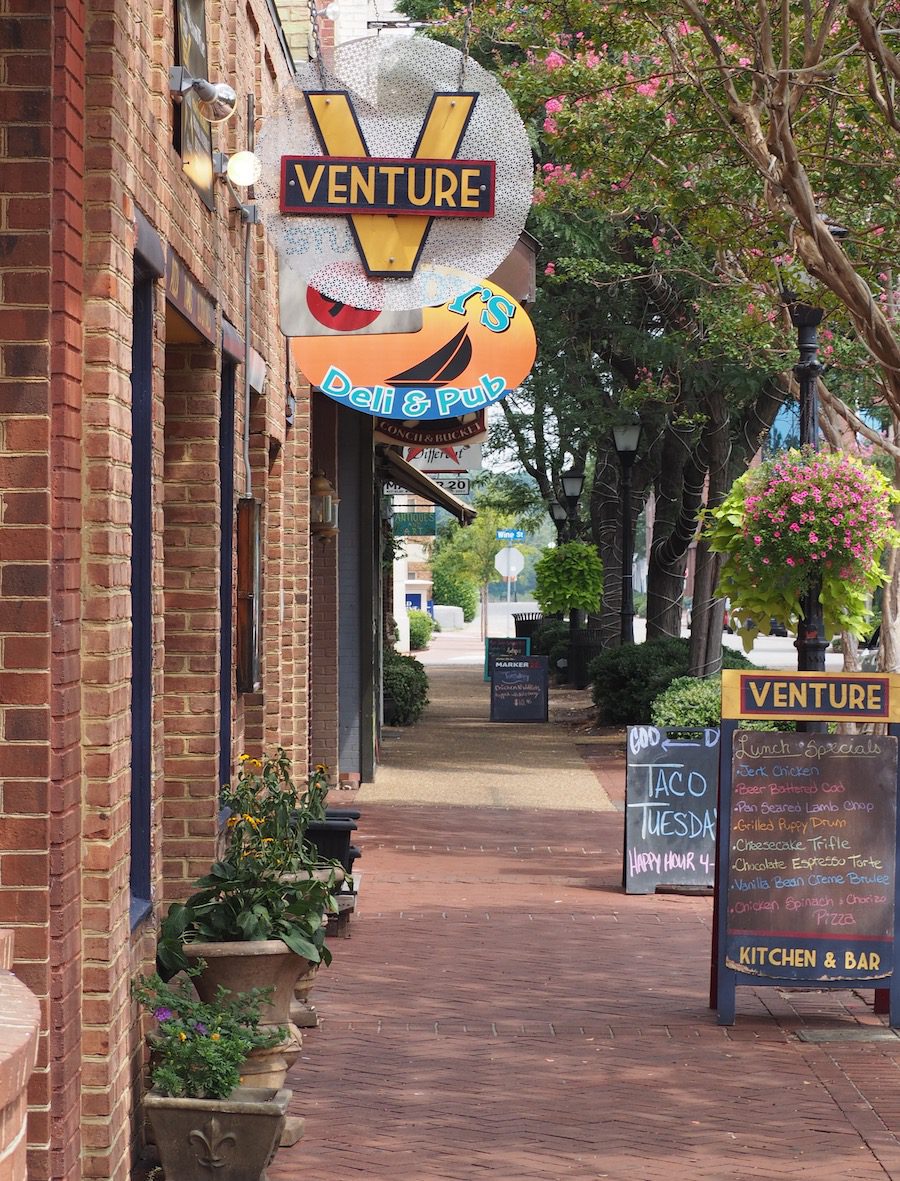
Located at the crossroads of the Atlantic Ocean, Chesapeake Bay, James River, Elizabeth River and Nansemond River, a visit to Hampton and Newport News makes a great extension to a trip to Virginia Beach, Norfolk, or the Williamsburg area. We included a stop in Hampton in our two-week Virginia road trip.
Hampton is approximately 160 miles south of Washington, D.C. and about 95 miles east of Richmond, Virginia. To get to Hampton, Virginia, you can fly into the Norfolk International Airport, which is located about 20 miles from the city center.
If you are driving, Hampton is located at the intersection of Interstate 64 and Interstate 664. There are several major highways that lead to Hampton, including Interstate 95, which runs north-south along the east coast of the United States. Or, you could take Route 13 across the Chesapeake Bay-Bridge Tunnel.
What is Hampton VA Known For?
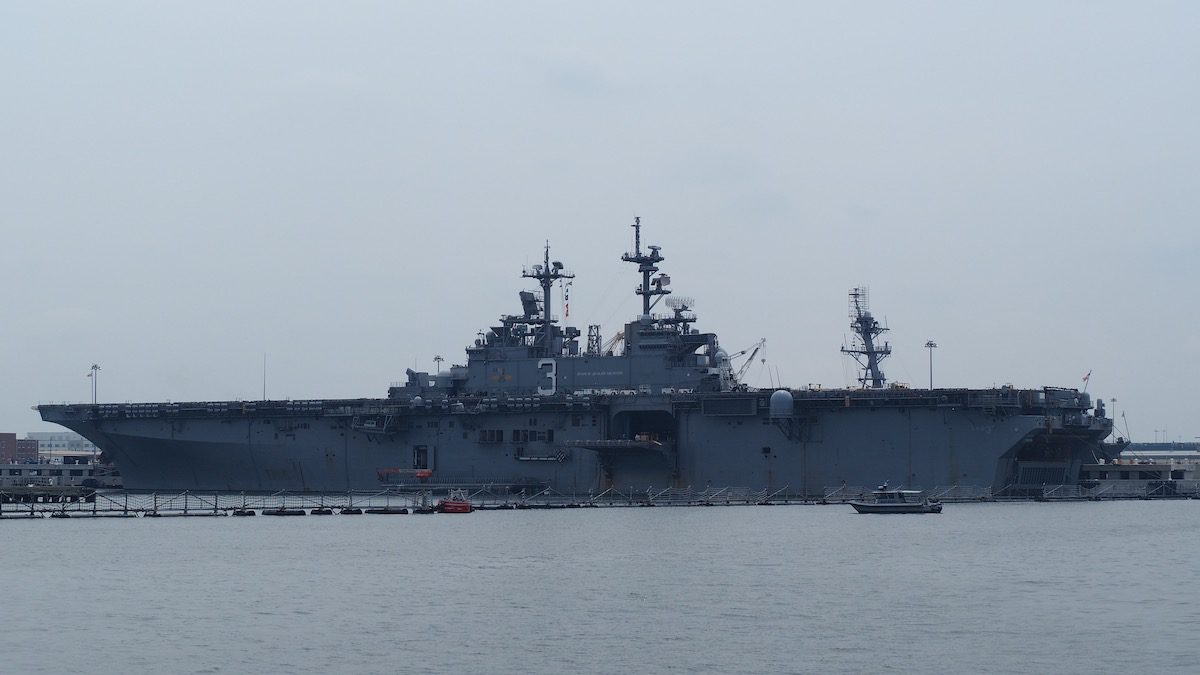
The waterways of Hampton Roads, named after Henry Wriothesley, the 3rd Earl of Southampton, played critical roles in the early defense of the nation and in the Civil War. Located at the entrance to the largest estuary in the world, controlling Hampton Roads means controlling trade in this area. Today, the Hampton Roads Bridge-Tunnel is a 3.5-mile long tunnel that connects Hampton with Norfolk and is a major transportation route in the region.
Controlling these waterways is what prompted the U.S. government to build two stone forts, Fort Monroe and Fort Wool, to protect this channel. It is also what prompted the infamous “Battle of the Ironclads” between the U.S.S. Monitor and the C.S.S. Virginia (aka the U.S.S. Merrimack) during the Civil War.
Hampton earned its “sea to the stars” motto through its critical role in sending men to the moon. NACA, the predecessor to NASA, located at Langley Research Center in Hampton, was the first headquarters for the manned missions to the moon. In fact, many of the original astronauts were from Hampton and Newport News. The Langley Research Center is responsible for research and development in aeronautics, atmospheric science, and space technology.
Founded in 1868, Hampton University, a historically Black university is one of the top universities in the United States and is known for its programs in business, engineering, and science.
Hampton is also known for the Hampton Coliseum, a multi-purpose arena that hosts concerts, sporting events, and other live performances. With all this rich history, there is so much to see and learn in Virginia’s Tidewater region.
Things to do in Hampton, Va
Note: Our visit to Newport News and Hampton, Virginia was hosted by Visit Newport News and Visit Hampton. We were given free admission to these attractions to facilitate this review. All opinions are our own.
If you want to learn more about the history of this area and its impact on the entire nation, here are a few must see attractions.
Hampton History Museum

Your first stop should be the Hampton History Museum. Located right in downtown Hampton, this small but beautifully done museum does a great job of walking you through the entire history of the area. You start off with the Native American Powhatan nation, then move into the early colonists, through the Revolutionary War and into Antebellum Hampton. The exhibits utilize artifacts found in archeology digs in Hampton, recovered from families, or recreated with great care.
While the museum covers Hampton Roads’ role in the Civil War, including the important Battle of the Ironclads, you’ll actually get a much better view of that slice of history at the U.S.S. Monitor Center at the National Mariners’ Museum in Newport News.
What the museum does introduce is the role General Butler played in declaring enslaved people seeking asylum at the Union fort as “contraband” and refusing to return them to their enslavers. This eventually led to thousands of escaped formerly-enslaved people living at Fort Monroe.
In the space of an hour or so, you can walk through four hundred years of Hampton history, including its pirate history (the head of Blackbeard was placed on a stake at the river entrance as a warning), the post-war era of grand hotels, the rising crab and oyster industry, and the all-important role in putting a man on the moon.
The Hampton History Museum is located at 120 Old Hampton Lane in Hampton, VA.
Fort Wool (via Boat Tour)
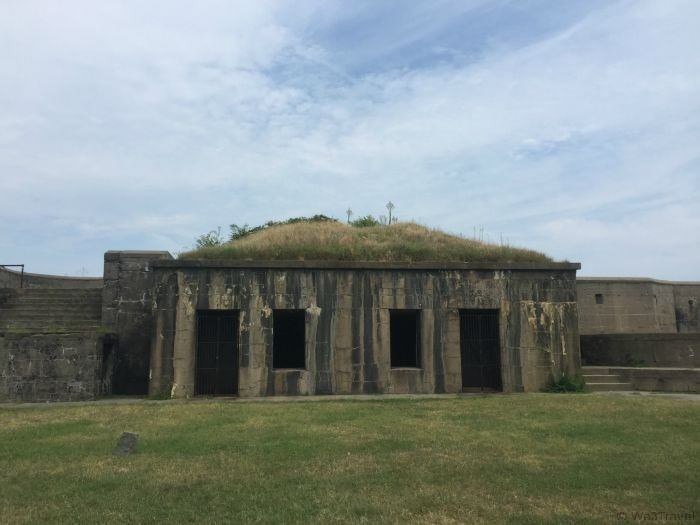
Fort Wool is located on a manmade island at the mouth of Hampton Roads, and therefore only accessible via boat. To get there, you will need to take a bay cruise. This was formerly offered by the Miss Hampton II, but sadly that has closed permanently. The tour we went on passed by Fort Monroe and gave an up close look at the Norfolk Naval Yard. The tour also included a 30-minute stop at Fort Wool, where energetic Park Rangers filed us in on the unique history of the island and fort, including the manufacture of the island itself.
Not always called Fort Wool, its original name was Fort Calhoun, for President Jackson’s Secretary of War, John C. Calhoun. However, once South Carolina seceded from the Union and Calhoun returned home, the fort was renamed after Major General John Ellis Wool, a Mexican War hero and commander at Fort Monroe.
Fort Wool was originally built as a companion fort to Fort Monroe, to provide crossfire. However, it provided very little utility during the Civil War, as its batteries were facing the wrong way to protect against the Confederates coming up the river.
Despite its location in Virginia, Fort Wool and Fort Monroe always remained in Union control. Once a favorite escape for President Jackson, not much of significance remains today but the tour about its colorful history is worth the stop.
The Casement Museum at Fort Monroe
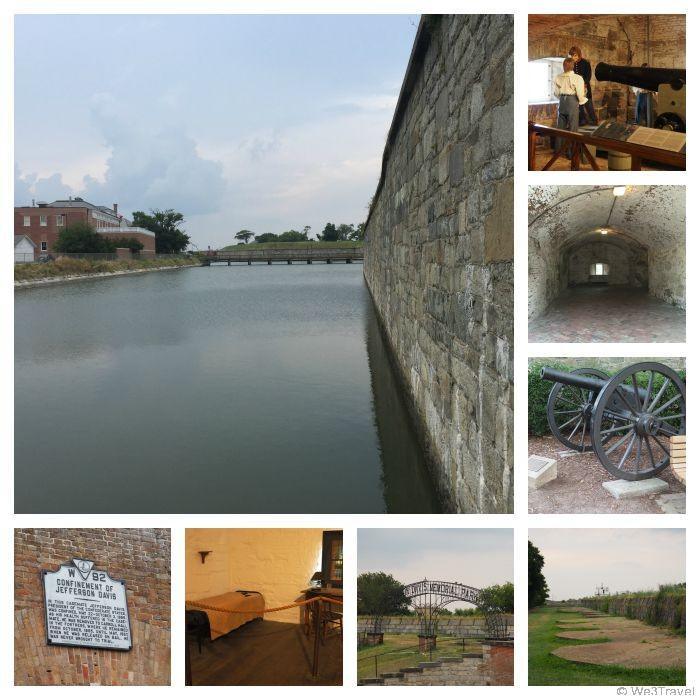
Since its completion in 1834 until its decommissioning in 2011, Fort Monroe was an active military base. The largest stone fort in America, and the only one to be surrounded by a moat,
Fort Monroe has played an important role in American history. It was the place that freed Black and enslaved people came to seek asylum, and commanding officer General Butler declared them “contraband” and refused to return them to their enslavers. It was a place where a Robert E. Lee and even a young Edgar Allen Poe served for a time. Perhaps most famously, Confederate President Jefferson Davis was even imprisoned here for two years after the Civil War.
Today its history is preserved in the Casemate Museum at Fort Monroe. When we visited, I was perplexed because I wasn’t familiar with the term casemate. Basically within the stone walls of the fort are casements, or small stone rooms which once housed the cannons that protected the fort and the channel it was guarding.
These casemates served as living and social quarters for the soldiers and officers stationed here. Today quite a few of the casements have been converted into a museum that tells the history of the fort through exhibits and dioramas. The museum began as a place to preserve the cell where Jefferson Davis was held. Today you can see the cot and the handcuffs used to keep him there. While the cell was very barren, it is decorated by a large American flag hanging right across from the cot, used to taunt Davis.
For a fort that most people have never even heard of, it has played a crucial role in our country’s history and is worth a visit when you are in the area. In addition to the museum, you can walk along the walls of the Fort, visit the soldiers’ pet cemetery, take a stroll along the water’s edge with views of Old Point Comfort Lighthouse, or visit one of the area’s beaches.
The Casement Museum at Fort Monroe is located at 20 Bernard Rd in Fort Monroe, VA.
The U.S.S. Monitor Center at the National Mariners’ Museum
The National Mariners’ Museum hosts an interesting collection of maritime history, including a stunning collection of miniature ships, all handcrafted by the same artisan. But the real crown jewel is the new U.S.S. Monitor Center.
Opened in 2007, the 63,500-square-foot U.S.S. Monitor Center houses the original turret from the Union Ironclad ship, the U.S.S. Monitor. While the turret is still encased in chemicals as part of its preservation since being raised from the ocean floor in 2002, a reproduction and many original artifacts from the ship are on display.
The Center does an excellent job of telling the story of the two Ironclads, the U.S.S. Monitor versus the C.S.S. Virginia, which was once the Union ship Merrimack, but was damaged and then raised by the Confederates and transformed into the Ironclad Virginia. Visitors can watch a video about how the Monitor sunk in a storm off the coast of Cape Hatteras, enter a replica of the CSS Virginia as she is being built for battle, learn about the building of the U.S.S. Monitor, and visit the living quarters of sailors in a full-scale reproduction of the Monitor.
What really impressed me was the excellent presentation in the Battle Theater that gave a blow-by-blow visual description of the Battle of the Ironclads at Hampton Roads. The Center also offers special “hands on with history” programs that give visitors the opportunity to actually handle some of the artifacts from the Monitor. We had a chance to hold silverware that had been rescued from the ocean floor, a sconce from the Monitor, and a handle that was used to signal the direction to turn the turret.
The National Mariners’ Museum is located at 100 Museum Drive in Newport News, VA.
NASA Virginia Air and Space Museum
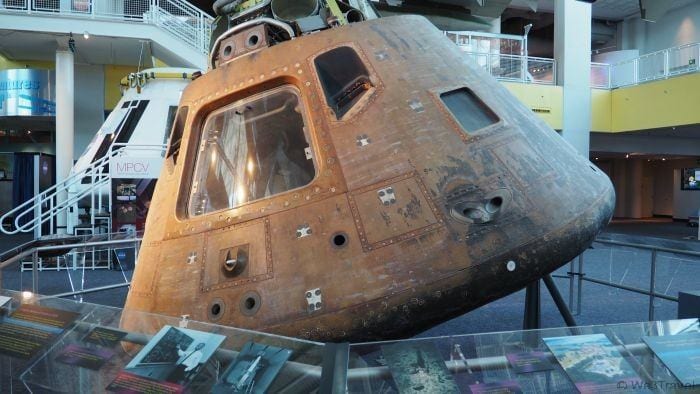
As we entered the NASA Virginia Air and Space Center (VASC) in Hampton, Virginia, our tour guide, Volunteer Coordinator Ken Flick, told us how his interest in space started early and as a teen he would watch the astronauts practice landing on the moon using the Lunar Excursion Module Simulator. It is no surprise that Ken grew up in awe of our space program.
After all, in 1958 nearby Langley Research Center was chosen as the site where NASA would plan America’s conquest of space and train its first astronauts. The Mercury Seven astronauts, Scott Carpenter, Gordon Cooper, John Glenn, “Gus” Grissom, Walter Schirra, Alan Shepard and “Deke” Slayton were stationed there to train for Project Mercury and, as a boy, Ken had a chance to meet a few of these courageous heroes. Some of these “spacemen” were even local heroes, like Alan Shepherd, the first American in space, who lived in Virginia Beach.
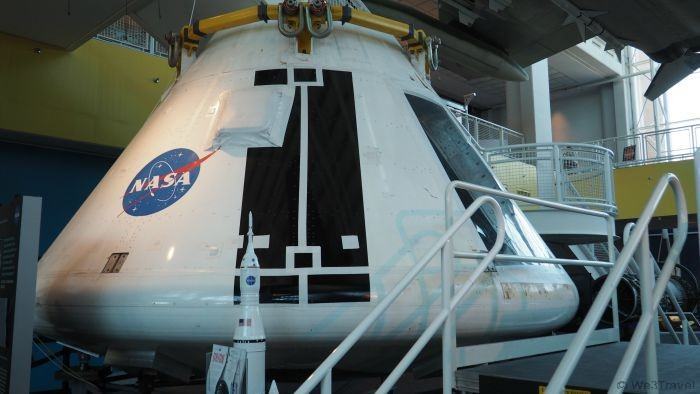
The Center’s main goal is education. In addition to over 100 “hands on” exhibits, the Center offers educational programs and STEM classes, including a robotics lab that caters to children as young as preschool. Starting with the history of aviation from the Wright Brothers (did you know that their first flight really took place in Kill Devil Hills, not Kitty Hawk as widely thought?) to the future Orion mission to Mars, the Virginia Air and Space Center covers it all.
Covering the history of flight, the VASC features a replica of the Wright Flyer (the original is in the Smithsonian) to a full DC-9 airplane in which kids can practice their aviation skills with a flight simulator. It is also the only place you can find vehicles from four out of the five manned space missions that were either tested or used in space – Mercury, Gemini, Apollo, and Orion. The only one missing is the space shuttle.
As we learned about the tight quarters that the astronauts endured for days welded into the small early space capsules, we were amazed by their seemingly endless courage. Even though we had visited the Kennedy Space Center in Florida a couple of years ago (I highly recommend it!) and the Smithsonian Air and Space Center in Washington D.C., we learned more about the Mercury and Gemini space missions in one morning at the Virginia Air and Space Center than those two visits combined.
Of course while history is fascinating, the future is what really captures your imagination. In addition to the Orion capsule, the VASC has a large exhibit dedicated to the history of the Mars Rovers and the future of the Orion missions. Your ticket also includes entrance to one of their many IMAX shows in each admission. We took advantage of this with a viewing of Journey to Space, a 45-minute 3D movie that explains the current state and future of the Mars missions.
Afterwards, you should pop over to the Air Power Park to see the missiles, rockets, and planes on display.
The NASA Virginia Air and Space Museum is located at 600 Settlers Landing Rd, Hampton, VA 23669.
Virginia Living Museum
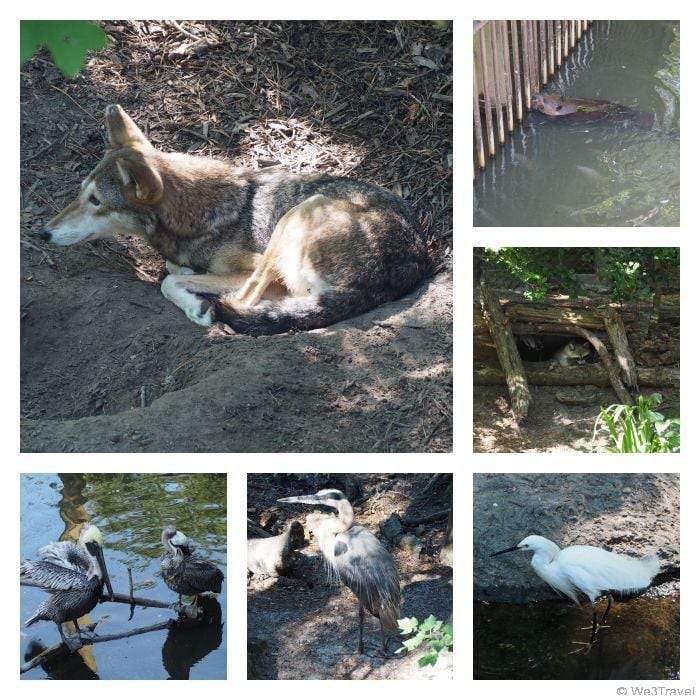
The Virginia Living Museum houses more habitats, wildlife and plant species then would be encountered in a lifetime of outdoor adventures in Virginia. It’s here that you can walk through an Appalachian mountain cove and a southeastern cypress swamp, touch a horseshoe crab or a sea star, go eye-to-eye with a red wolf and a bald eagle and watch otters frolic on the outdoor natural trail! Be sure to allow at least two hours to explore.
The Virginia Living Museum is located at 524 J Clyde Morris Blvd, Newport News, VA 23601.
Hampton Carousel
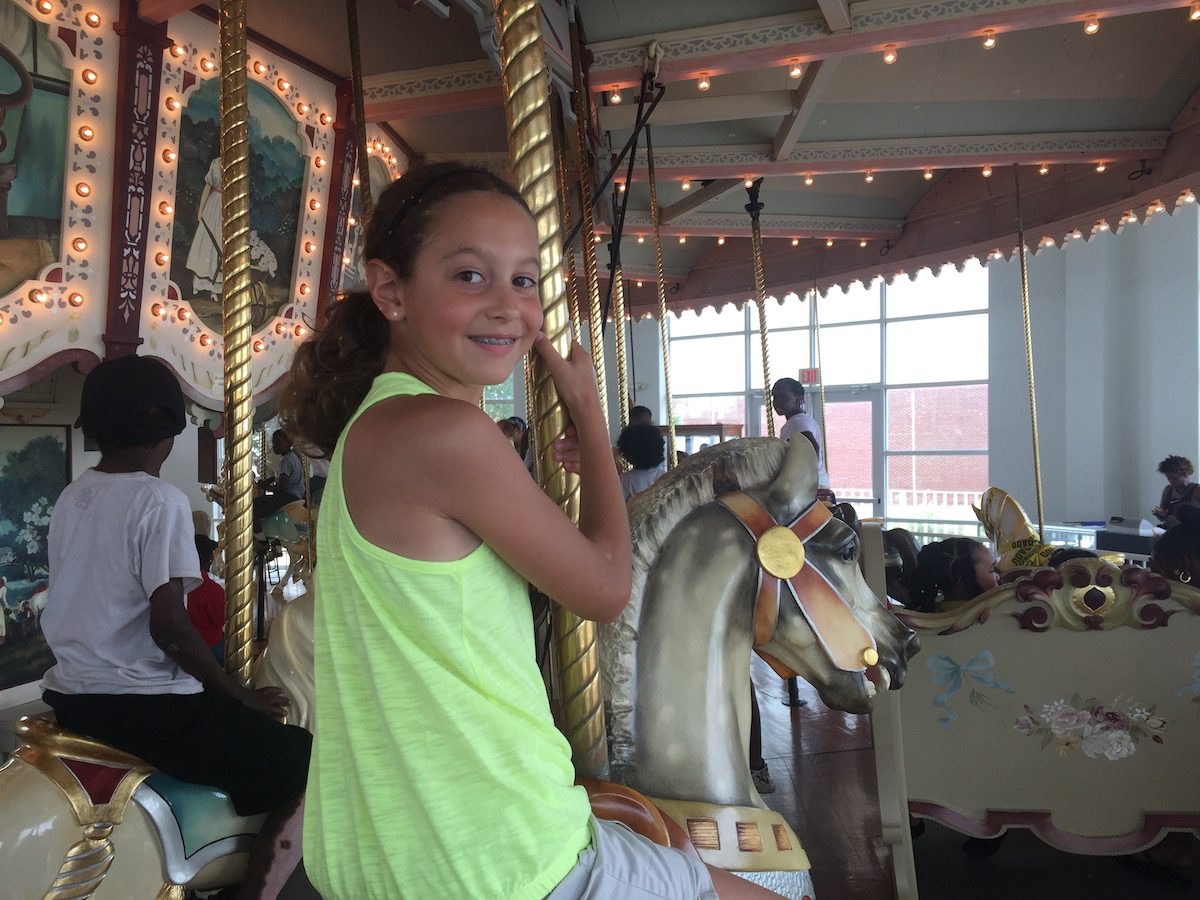
The Buckroe Beach Carousel, also known as Philadelphia Toboggan Company Number Fifty and the Hampton Carousel, is a historic carousel operated by the Hampton History Museum located on the Hampton waterfront. This is a fun way to break up the historical attractions with a little family fun.
Sandy Bottom Nature Park
Sandy Bottom Nature Park is a 456-acre park that features a 10-acre lake, wooded trails, a nature center, picnic areas, playgrounds, and other recreational facilities. The park is home to a variety of plant and animal species, and visitors can observe wildlife in their natural habitat. The park also offers educational programs and events for people of all ages, including guided nature walks, bird watching, and fishing clinics. It is a popular destination for families, hikers, anglers, and anyone looking to enjoy the outdoors in a natural setting.
Sandy Bottom Nature Park is located at 1255 Big Bethel Rd, Hampton, VA 23669.
Bluebird Gap Farm
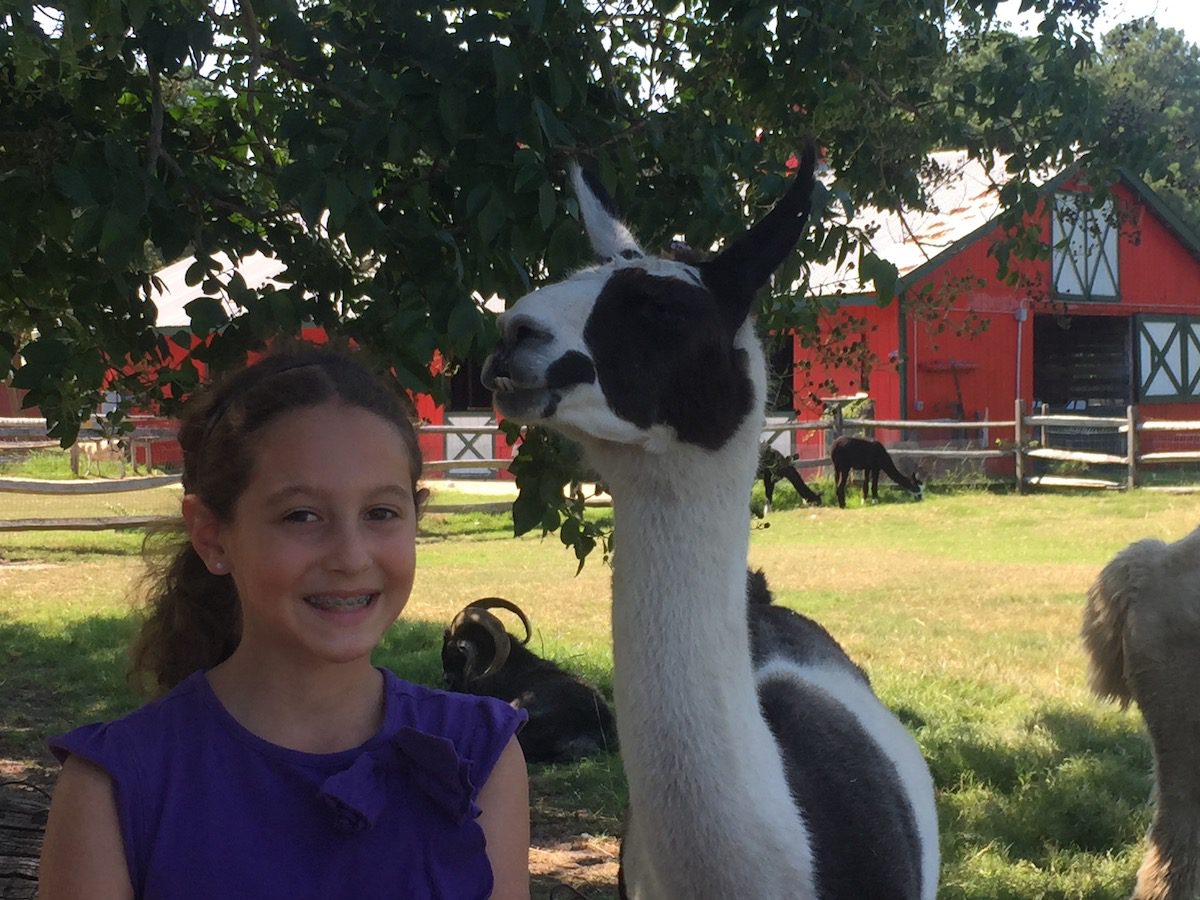
Bluebird Gap Farm is a public city park that is a good stop for families and animal lovers. The park covers 60 acres and features a variety of farm animals, including cows, goats, pigs, chickens, and horses, as well as a small collection of exotic animals, such as llamas, peacocks, and wallabies.
You can enjoy a range of activities, including feeding and petting the animals, taking a wagon ride, visiting the butterfly garden, and hiking the park’s nature trails. The park also features a playground, picnic areas, and a stage for live performances.
Bluebird Gap Farm is located at 60 Pine Chapel Rd, Hampton, VA 23669.
Where to Stay in Hampton VA
When staying in the area, the Newport News Courtyard by Marriott and Hampton Hilton Garden Inn both offer good options for families.
Where to Eat in Hampton VA
The Tidewater region of Virginia is known for its seafood – especially the blue crabs, oysters, and local fish like rockfish. In fact, Hampton, VA was even known as “Crabtown” and has been home to oyster and crabmeat packing companies. The area is also seeing a movement toward local and farm-to-table restaurants, creating a hip new vibe downtown.
n the Phoebus district and Downtown Hampton, you will find many trendy options including the following:
Crackers
Crackers is a funky martini and tapas restaurant in the trendy Phoebus area of Hampton. Located on a sleepy downtown street, this small restaurant features an extensive cocktail menu including two pages of a wide variety of martinis. Not a traditional Spanish-style tapas restaurant, Crackers has an interesting sampling of hot and cold tapas.
We started with the chicken lettuce wraps, cold soba noodles, and smoked salmon bruschetta. Moving on to hot tapas, we sampled the spicy green chicken curry over rice and zucchini pancake. While not a good choice for picky eaters, the small plates make Crackers a fun stop for friends or families with more adventurous palates.
You can find Crackers at 4226 Granby St, Norfolk, VA 23504
Venture Kitchen and Bar
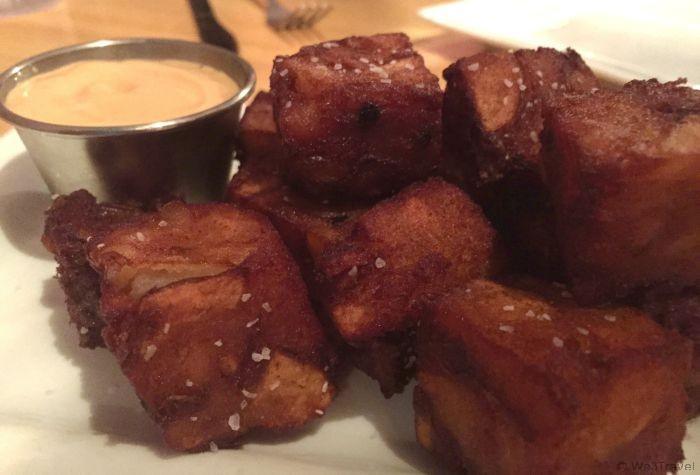
Located in downtown Hampton, just steps from the Virginia Air and Space Center or Hampton History Museum, Venture is popular for its wood-grilled pizzas and homemade tater tots. Unlike anything Ore-Ida ever concocted, the tater tots at Venture are made with mashed potatoes, instead of shredded. The potatoes are mashed, frozen in trays, then cut into one-inch cubes and fried. Served crispy with a soft center, they are accompanied by a spicy aioli.
The pizzas are just as tasty. Offered as individual servings, you would need to be quite hungry to finish one, so I would recommend sharing. We sampled both the white pizza with seasoned ricotta, cauliflower and roasted garlic and the Margherita. The white pizza was so good but I’d recommend going easy on the garlic as they throw a lot of whole cloves on there and it tends to blend easily with the cauliflower. The margherita pizza was also delicious with fresh mozzarella, tomatoes, and drizzled with balsamic vinegar. Venture makes a great choice for families at either lunch or dinner.
Venture can be found at 9 East Queens Way in Hampton, VA and can be reached at 757-325-8868.
PIN THIS FOR LATER
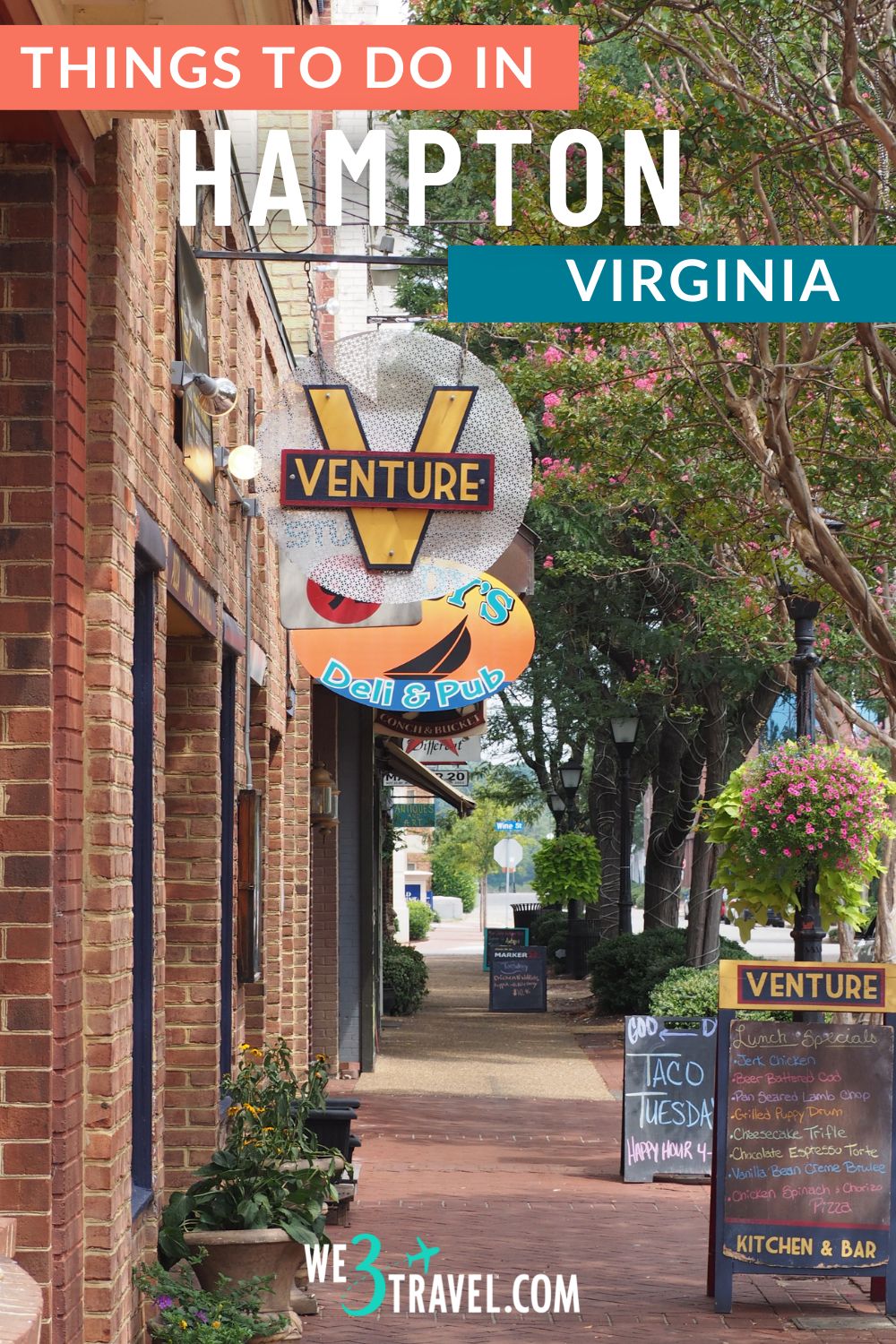
The post Discover the Rich History and Top Things to do in Hampton, VA appeared first on We3Travel.

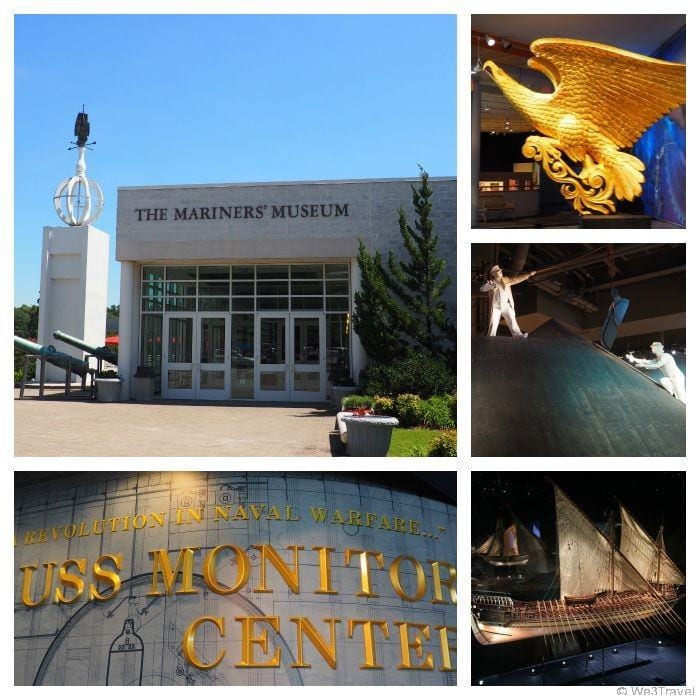
Leave a comment